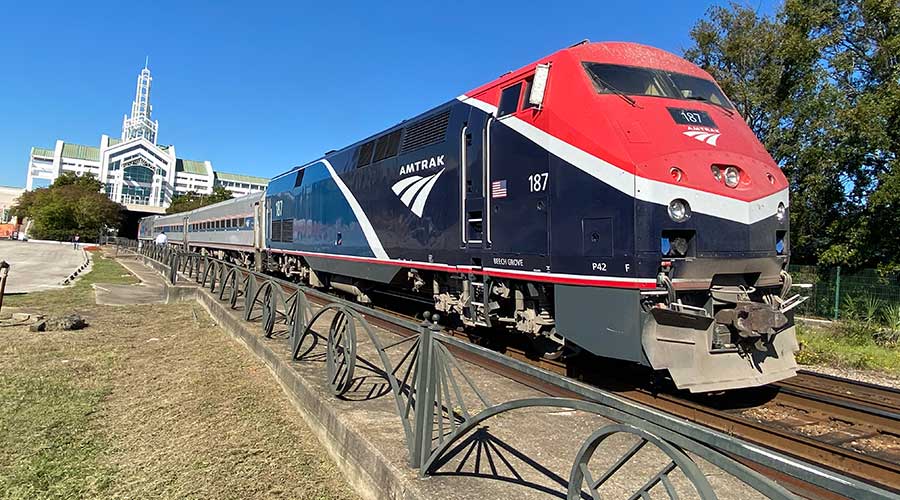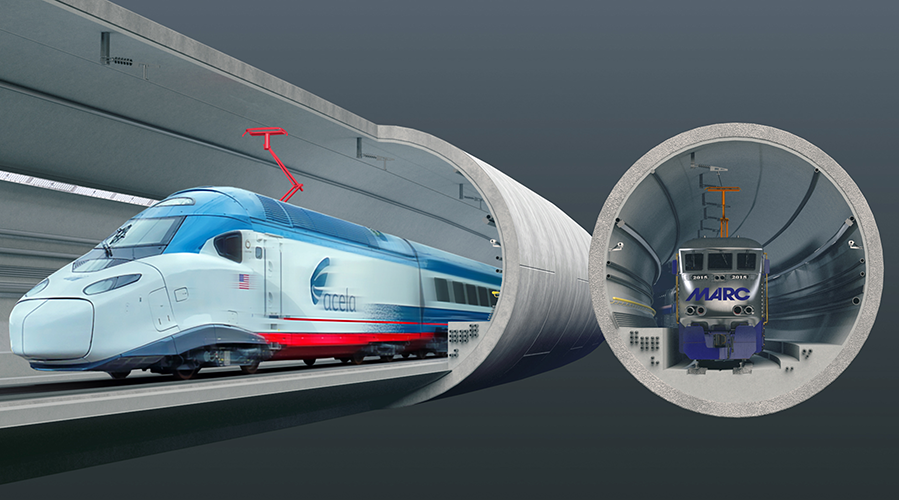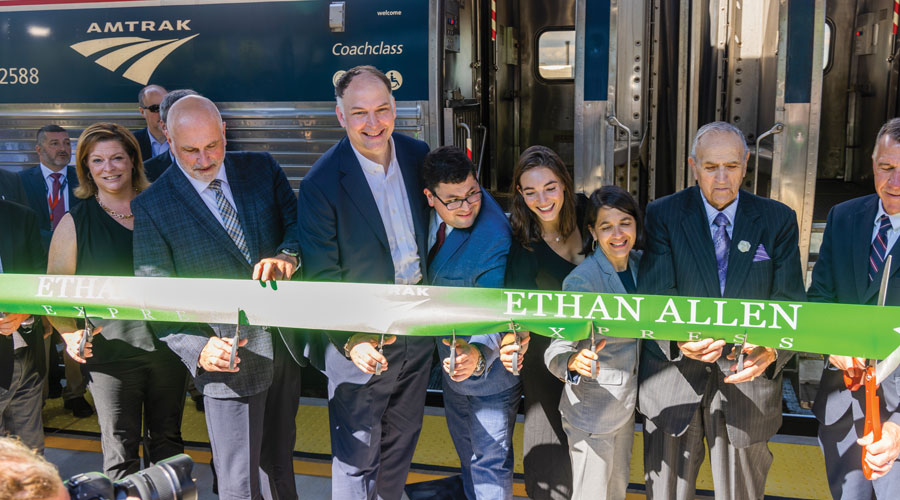Stay updated on news, articles and information for the rail industry
August 2012
Rail News: Amtrak
Amtrak's new strategic plan will help railroad become more efficient, customer focused, execs believe
by Angela Cotey, Associate Editor
As an 18-year Amtrak veteran and the longest-serving vice president currently on board, Joe McHugh has had a front-row seat for many of the company's most memorable moments — the good, the bad and the sometimes ugly.
McHugh, who began his Amtrak career as director of government affairs, recalls some of his early memories with the organization: stories told by Amtrak's founding fathers about the railroad's formation and plight to gain acceptance; Amtrak's quest to develop high-speed rail in the Northeast Corridor; and the vision of Amtrak's old heritage equipment in operation.
"Watching the Montrealer sail off into the winter night, with all the lights shining and people eating their dinner — there's something very beautiful about that," he says. "We've since shed a lot of that nostalgia."
There's nothing like a crisis — or two or three — to contribute to the nostalgia-shedding. The late 1990s were marred by slashed budgets that required Amtrak officials to implement a series of route and service cuts, a process McHugh says was "one of the most awful things we put ourselves through."
"Once [those routes] are gone, they're gone," he says.
In the early 2000s, Amtrak nearly went bankrupt, and McHugh was almost certain the railroad would be shut down.
"We often worried, 'What were we, really?'" says McHugh, now Amtrak's vice president of government affairs and corporate communications. "Were we the people who picked up something that was withered and dying and took it to the next level? Or were we torch-carriers who kept the railroad going until something else came along?"
Today, McHugh and other Amtrak executives are much more confident in the role they play with the national intercity passenger railroad. Since the late 2008 passage of the Passenger Rail Investment and Improvement Act (PRIIA) and subsequent approval of the American Recovery and Reinvestment Act, Amtrak has had a steady stream of authorized operating and capital dollars flowing in. With that money, the railroad has launched construction or design work on long-awaited, large-scale infrastructure projects. Amtrak officials also have worked to implement a new rating system to prioritize projects and new financial processes to increase transparency — which, in turn, has helped railroad execs communicate more effectively with members of Congress.
As a result, Amtrak's once-uncertain future looks much more promising. And that means the management team needs to have a direction for it. As Vice President of Operations DJ Stadtler puts it: "We've been trying to become less about day-by-day managing and more about long-term vision managing."
To help get them there, Amtrak execs in October 2011 unveiled a strategic plan that, in part, calls for dividing the company into six business lines. The strategy will help Amtrak better manage performance and serve customers, says President and Chief Executive Officer Joe Boardman.
This isn't the first time Amtrak has created a strategic plan. It's not the first time execs have tried dividing the company into segments, either. Amtrak implemented strategic business units in the 1990s that divided the company into regional operating divisions and essentially created various companies within the organization, each of which had its own human resources manager, chief financial officer and the like. The units also had their own goals, priorities and strategies, which created segregation between employees. In the end, the plan was ditched because of its high cost.
Boardman & Co. believe their plan is different. The funding stability that's given managers the opportunity to think big-picture will help them execute the plan. No longer worried about whether the organization will exist by the next fiscal year, Amtrak managers now can focus on carrying out longer-term strategies. Plus, Boardman has been on the job for almost four years and had plenty of time to observe the railroad's operations and gain a firm understanding of what's working and what's not.
The plan is being rolled out in a slow-and-steady fashion. Senior managers spent nine months developing the blueprint with input from Amtrak employees; they expect it'll be another year before the plan is fully implemented. By easing into the restructuring, execs will have time to appoint the managers they believe will be the best fit, shift employees as needed under the business line approach and set realistic yet challenging performance targets.
Once the plan is fully in place by FY2014, Amtrak officials envision the organization will more closely monitor expenses, maximize opportunities to capture revenue, better nurture relationships with state partners, and better coordinate transportation, operations and mechanical functions.
"We want to run this company more as a business and less as a government entity," says Boardman.
At least, as business-like as an organization that relies on a government subsidy can be. Members of Congress have been requesting that Amtrak develop a strategic plan for years, and while some past CEOs have come up with ideas, "they were really more technical than they were strategic," says Boardman.
To current Amtrak managers, it became important to set a realistic strategy for the future.
"There was a clear need for a vision that was longer than the day after tomorrow," says Stadtler, who in May was appointed vice president of operations after holding the post on an acting basis since December. He previously was Amtrak's chief financial officer.
For starters, Amtrak officials identified goals related to safety and security, customer focus, mobility and connectivity, environment and energy, and financial and organizational excellence. To achieve them, managers established corporate strategies, such as integrating field operating departments with geographic divisions to maximize collaboration, efficiency and service delivery; expanding a program to improve the railroad's safety culture; improving workforce development initiatives; and investing in more systems and technology that help reduce energy consumption and operating expenses.
Every function of the railroad needs to align around those strategies and goals, Boardman says. Dividing Amtrak into six business lines — and creating performance targets to measure their success — will help keep managers and employees on track to meet those goals, he says. The business lines are: Northeast Corridor (NEC) services, long-distance services, state-supported services and commuter services, Northeast Corridor infrastructure and investment development, and commercial asset development.
"We're trying to better reflect the different elements of Amtrak, and create more transparency and accountability," says Stephen Gardner, who in November 2011 was appointed vice president of NEC infrastructure and investment development. He previously was Amtrak's VP of policy and development, a department that no longer exists. "What we really have are two separate businesses: Amtrak operations, which are very much focused on the needs of the consumer of the services; and managing the infrastructure and maintaining the railroad [in the NEC] that's more for institutional customers, like commuter and freight railroads."
Operations Overhaul
That's why Amtrak is lumping four of those business lines — NEC, long-distance, state-supported and commuter services — under the operations department, which is being revamped to integrate the transportation, mechanical and engineering departments into a single unit. General managers will be appointed to oversee the four business lines and be responsible for the profit and loss of their respective units.
At the beginning of each fiscal year, managers will be given targets for estimated revenue and expenses. They'll also be measured on a series of metrics, such as on-time performance, customer satisfaction, cost recovery, and how long a rail car or locomotive is in a shop.
Amtrak officials plan to offer financial incentives to managers and employees that work to hit or beat targets.
Chipping In
Amtrak managers and employees already are analyzing ways they can shave expenses. One small example: finding a way to prevent bags of potato chips onboard California Zephyr trains from popping when the train travels over the mountains.
"That happens every day and ruins a couple bags of chips," says Stadtler. "We didn't look at that and say, 'That's money we're losing.' Now it's been identified as a problem and we're fixing it."
Whether taking small steps to minimize waste or larger steps to reduce Amtrak's required subsidy, all employees will need to get past the "business as usual" mindset and generate new ideas — or, at the very least, more actively consider how their actions affect the bottom line.
"People weren't paying attention to revenue. Sometimes they weren't paying attention to expenses, either," says Boardman. "We want people to be looking at why they are spending money and where they can generate more revenue, like by upselling if we have open beds or availability in the diner car. That's part of what business is about."
It's also about serving the customer. Stadtler plans to hammer home the "customer first" message to employees in the operating division — from the transportation, mechanical and engineering departments alike.
"They have to work together to make sure every step in the process — from making a reservation to getting on a train to arriving at a destination — is a positive and safe experience," he says.
But getting employees to think differently about their jobs and how they perform them, and how they impact both the customer and bottom line, isn't easy. That's why Stadtler knows he'll need to practice what he preaches.
"I need to lead by example, and I try to do that every day," he says.
Stadtler and other Amtrak managers also are trying to involve employees in the process.
"We're reaching out to employees asking them what they would do differently and what we can do to make things more efficient. A lot of them tell us that no one's ever asked them that before," Stadtler says. "People are all of a sudden energized and excited about coming up with ideas to improve the bottom line and customer experience."
The customer experience was top-of-mind when Amtrak managers developed the plan to integrate the mechanical, engineering and transportation departments into the operations department. By having a more streamlined division with general managers reporting to one vice president — who oversees all functions necessary for Amtrak to provide adequate service — passengers will be served faster and more reliably.
"One of the things that never made sense to us was that the commissary fell under marketing and trains fell under transportation. The train would be ready to go and the food wouldn't be there yet," says Boardman. "There was this lack of coordination that in some cases prevented work from getting done."
When it comes to Amtrak customer service, the term doesn't only apply to those who ride trains. The railroad also needs to nurture relationships with the states that help fund Amtrak service and transit agencies that operate on Amtrak-owned lines throughout the NEC.
Boardman has appointed McHugh to oversee the state-supported and commuter services business lines in addition to continuing his government affairs duties. McHugh' duties will be two-fold, he says: continue to foster relationships with the transit agencies Amtrak has operating contracts with, and maintain support for Amtrak service at the state level.
"It's important to help state partners make the case about the value of the service so they can get their state legislators to invest in it," he says.
A Full Plate
Getting that message across now is more important than ever. With the upcoming elections and inevitable influx of new congressmen, McHugh's team will need to educate incoming legislators about Amtrak service and why it should be funded. They'll also be working to implement Section 209 of PRIIA, which requires that states pay 100 percent of their direct costs and capital costs for the services they purchase from Amtrak. The agreements need to be in place by 2014.
"We will be held accountable for making sure those contracts are done, payments are up to date and issues with state partners are resolved quickly," says McHugh.
Meanwhile, for Gardner's NEC infrastructure group, the primary focuses are completing projects under way, such work in New Jersey to upgrade infrastructure and raise train speeds; advancing state-of-good-repair projects, such as the Portal Bridge; and further developing plans to create a next-generation high-speed rail system in the Northeast.
"Our business line really is about trying to develop and improve the infrastructure, from the right of way to the facilities to the stations — all the physical assets here that make up Amtrak's portion of the Northeast Corridor," he says.
Gardner also is responsible for working with Amtrak's NEC partners — states, commuter railroads and freight railroads — to create a long-term vision for the NEC and determine how infrastructure improvements could be funded.
"Heretofore, Amtrak's involvement with the states has pretty much been confined to the borders. Same with commuter railroads — they're interested in what's happening in their section of the corridor and aren't necessarily thinking big picture," says Gardner. "But this network, with its constrained capacity, a sneeze in Baltimore is a cold in New York."
Now, Gardner is pushing state departments of transportation, and commuter and freight railroads to look at the NEC in a more holistic way.
"When we think about what the Northeast Corridor needs to become in 10, 15, 20 years, that's a conversation we have to have collectively," he says. "If we don't have a way to pool our resources and do things collaboratively, we won't be able to make investments for the future. We need to try to find the investment package that will support the needs of the different markets this corridor serves."
'One Amtrak'
Managers within the various business need to collaborate, too. Once the strategic plan is fully implemented, it will be critical that the VPs and general managers communicate their progress and share ideas with each other.
"We'll have four operating business lines and two Northeast Corridor business lines, but we're still going to be one Amtrak," says Stadtler.
And that organization will be geared toward one set of goals that ultimately will help improve customer service and cost efficiency. The progress Amtrak might make on both counts will be of the slow-and-steady kind. But if execs can continue to capitalize on the railroad's current stability, they believe they can help rail play a larger role in intercity passenger travel.
"It's a difficult thing to go from maintaining a railroad to expanding and improving a railroad," says Gardner. "We're situating Amtrak for growth and greater customer focus because we all think Amtrak has a much bigger role to play in the decades ahead."
A New Vision For D.C.'s Union StationAmtrak executives say they're thinking long term; last month, they showed it. On July 25, the railroad unveiled a master plan for Washington, D.C.'s Union Station that calls for revitalizing the terminal to increase capacity, accommodate future service expansion and provide a better passenger experience. The price tag: between $6.5 billion and $7 billion. The plan includes a new train shed to better organize connections to Amtrak, commuter-rail, transit and other transportation services. New passenger concourses and a series of new street entrances would be integrated with the existing station so passengers and visitors could access the entire complex. The station would be able to accommodate twice as many trains and three times as many passengers as the current facility, providing ample capacity for future high-speed, intercity and commuter-rail growth, according to Amtrak. The master plan also creates a framework for progressive capital investment with a phased construction approach that could be completed in 15 to 20 years. |


 2025 MOW Spending Report: Passenger-rail programs
2025 MOW Spending Report: Passenger-rail programs
 Gardner steps down as Amtrak CEO
Gardner steps down as Amtrak CEO
 Guest comment: Oliver Wyman’s David Hunt
Guest comment: Oliver Wyman’s David Hunt
 Women of Influence in Rail eBook
Women of Influence in Rail eBook
 railPrime
railPrime







